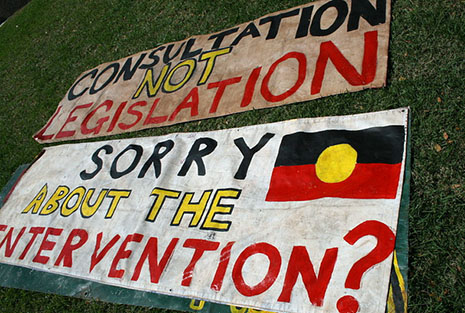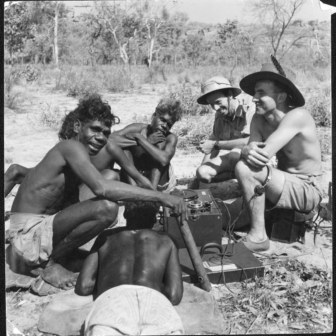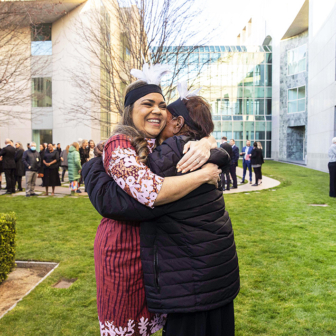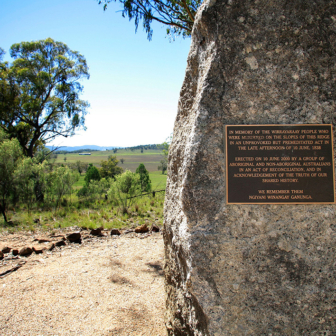FIVE years ago, on 21 June 2007, Australian armed forces descended on remote Indigenous communities with the national news media forming a rearguard. The media’s role in defining the Indigenous policy “crisis” that triggered the Northern Territory Emergency Response – the NTER or the Intervention – is well recognised, and the media continues to play its part as a policy trigger. But the news media shapes Indigenous affairs in this country in many other ways too. In a three-year project, we are currently investigating the ways in which “media logic” has permeated the practices of Indigenous affairs policy professionals at every level, from minister to junior bureaucrat, and its consequences for the lived experience of Indigenous Australians.
The Australian News Media and Indigenous Policymaking 1988–2008 project examines the role that Australia’s news media has played in the shifting and uncertain twenty-year policy history of Indigenous affairs between the bicentenary celebrations of 1988 and the national apology to the Stolen Generations in 2008. It has a strong focus on the Howard years, 1996–2007. We have investigated the media-related experience of those deepest inside the policy-making processes – the public servants responsible for developing, implementing and promoting Indigenous affairs policies. We have found that they are equipped with “media logic” involving a range of skills and tools to monitor, pre-empt and react to news media representation of their policy field. Many are also expert in critiquing the practices of journalism and politics and their consequences for policy.
The project has also analysed more than 4000 media reports to map the quantity and nature of media reporting of Indigenous policies during the eleven-year Howard period. We found news was structured around routine and predictable frames of crisis, policy failure and individual responsibility, and that reporting was not consistent but structured around periodic “critical moments.”
Analyses of the representation of Indigenous Australians forms another important dimension for our study by demonstrating the exclusion of Indigenous voices from the policy-making processes that affect their lives. This finding resonates with Indigenous intellectual Marcia Langton’s statement that “the first peoples exist as virtual beings without power or efficacy in the national zeitgeist.” In a 2007 Griffith Review essay she describes the media spectacle as a “perpetual Aboriginal reality show,” in which the everyday suffering of Indigenous people has become “a kind of visual and intellectual pornography in Australian media and public debates.”
Public servants working in Indigenous affairs sections of federal, state and Northern Territory governments spoke candidly in research interviews about the role of the media in their everyday practice. As they reflected on the way Indigenous policies had shifted, often dramatically, during the Howard decade, they also shared their expert knowledge about how media-related practices had been increasingly incorporated into their work. These policy-makers said the most dramatic policy decision in Indigenous affairs during the Howard decade was the NT Intervention. This suite of policies saw the Commonwealth override the Northern Territory and abandon its Racial Discrimination Act to impose policies including mandatory child health checks (later modified); alcohol, drug and pornography restrictions; and increased policing. The government also provided funding and programs for additional health and housing services.
A number of themes emerged from the interviews. First, it is clear that Indigenous policy bureaucrats have a sophisticated knowledge of news media processes. They described in detail how the media operates at the political, ministerial, communications and policy levels. Second, they also understand the media practices in their own policy fields. They identified that policy-making had become increasingly media-oriented over time, with the Northern Territory Intervention given as an extreme example of media-driven policy-making. Finally, policy-makers could reflect in a sophisticated way about the media-related nature of their policy-making, and its impact on policy outcomes during the Howard years.
Bureaucrats explained in detail how they incorporated media practice into their daily routines. They described how they monitored media coverage of issues they were working on, responded and reacted to media coverage, pre-empted positive or negative media coverage of their portfolio, and worked with their department’s media area to promote policy changes. In doing so they revealed that journalism and policy practice are much closer than we had previously assumed. The relationship is indirect, however; while public servants’ practices are intimately involved with the news media, very few outside of the communications area of the department or the minister’s office have direct contact with a journalist. A senior manager said, “There's certainly much more political sensitivity around responding to media and how it’s portrayed. But I don’t remember it ever being the norm that public servants would have spoken to media.”
Our study participants identified that media logic worked differently in the political realm and the policy or bureaucratic realm. The minister’s office operated on an agenda driven by political and public opinion imperatives, while these processes were less overt within government departments.
Many were deeply committed to the mission of improving Indigenous living standards, and had a strong understanding of the history, politics, science and environmental contexts of Indigenous issues. They understood that these factors work together to make Indigenous issues intractable, or “wicked,” problems susceptible to sudden policy changes.
One federal bureaucrat working in an Indigenous policy section said, “Of all the programs that my department runs, I would hit the media four or five times more than all the others… You have a journalist who is driving a story and an opposition who has a lot of interest in showing that there’s poor results.”
Those working at the most senior levels of the federal bureaucracy oriented themselves towards the minister and his or her office and therefore towards those political imperatives. They understood that issues that were the subject of intense news media interest had the potential to reflect poorly on the minister and therefore required tight media management.
Government departments also have established routines for monitoring media interest in their policy areas. Communications sections of each department employ media specialists to formally monitor media activity. As one senior manager explained, “Every morning I have somebody [a media relations officer] that comes into my office. So we have a communications branch, there’s a team in there. We buy a media monitoring service. That team pulls together clips. I’ve got a team in my group that particularly focuses on issues we know will be running. I can log onto my email at 8.00 and I’ll see the news clips. We’re very regularly in stories on the weekend, so I have a little text message service that comes to me from the communications area about what’s on page three of the Australian etc.”
They described the communications sections of their departments and their media-related activities as “hand in glove” with policy implementation. One senior NT bureaucrat said, “Media management and media interaction just became a necessary part of the functions, and particularly in terms of dealing with Indigenous remote contexts with all of the overlays… of the Intervention.”
Policy officials accept that responding to media stories is part of their job. If the monitored news is perceived to have political significance, “then that means we go into a media response arrangement. So we will pull together the information that’s required in order to respond to the story in a timely way.”
Another said, “So we do run on a media cycle every day, we check media… we do our media response work. We need to get our media response back so that you can get back into press the next day if you need to refute a story.”
POLICY-MAKERS explained how they took a strategic approach to the news media during the creation of policy. They work closely with Indigenous stakeholders in their area and know their stakeholders’ media strategies. They said that they increasingly pre-empted the media reaction from the start of the policy development process. One explained, “You have to be aware of the political implications of what’s going to happen if something you do goes public. Is it a good news story or a bad… if it’s not saleable to the general public … it won’t happen, or it will be defused, rather than put in place something that… the talkbacks or the tabloids might get hold of.”
Most participants were critical of the practices of “policy by press release,” “knee-jerk” policy and “policy on the run.” They argued that the short news cycle encourages bad policy, discourages evidence-based policy, discourages genuine community consultation, and discourages risky or long-term policy decisions. One middle manager said that a more senior colleague explained media-reactive policy-making:
I was in the hot seat and suddenly we had that one picture of a kid with a needle in Redfern… It made the entire world spin on its axis and suddenly we went off in this other direction. And [my colleague] used this as an example to me to say, “You can go to all these meetings till the cows come home but decisions are made on talkback radio and in the paper,” and it certainly seemed that way to me.
Senior bureaucrats demonstrated their expertise in straddling the political and policy realms, in what one called “managing the policy optics.” They emphasised that highly political issues that attract media attention can provide opportunities for those who understand the game. One middle-level department bureaucrat explained that it was their job to pre-empt the consequences of policy decisions, and massage policy outcomes for public consumption.
“It was one of their favourite words, the optics of it. Have you heard that one yet? Optics – how it looks to the outside. Yeah, do you hear that? It’s a very public servant word… the optics. When you’re dealing with stakeholders and you do something, it’s the optics. How will this be seen out there in the world?”
The policy professionals interviewed for our study said that not only had their practices adopted a media logic, but that media representation of Indigenous issues, and their responses to that representation, had affected specific policy outcomes. They identified the 2007 NT Intervention as a template for media-driven policy-making in Indigenous affairs. Some spoke with cynicism, describing the Intervention as the most dramatic episode in a long tradition of radical policy shifts. They also identified that Australia’s news media, led by the Australian, had chosen to represent health and wellbeing in remote territory communities as a policy crisis to which the only solution was to move away from policies of self-determination towards policies promoting individual responsibility. They realised that the long-term promotion through news media of an ideology of individual responsibility was entwined with political discourse and policy decisions that imposed behavioural change on individuals.
A senior federal bureaucrat said, “You look at the Aboriginal health strategy in 1989, the main push was self-determination. Since Howard, post Howard, with the refusal to say sorry and then the whole language changing from self-determination to practical reconciliation and all that, we’ve moved away from that acknowledgement that people need ownership – that people need to have this in their lives.”
Another offered the insight that Australia has adopted a “done- to” model of Indigenous affairs policy: “I'll do health ‘to you’ rather than the self-determination model which will give you the skills and empower you to do it for yourself… if you look at the Cape York Welfare Reform trial and if you look at the Intervention, then that was really the big culmination of ‘you can’t do it for yourselves.’ We’re going in now with a big stick and we’re going to do it for you.”
While the news media’s especially dramatic episodes of “the perpetual Aboriginal reality show” in 2006–07 may have been the trigger for the NT Intervention, our study shows that media-related practices are intimately woven into the everyday fabric of Indigenous policy-making. The development and implementation of the Intervention policies were heavily reliant on the internalised media logic operating within both the federal and territory governments. Media logic operated at all levels of the policy process, from development, through announcement, to implementation.
It seems inevitable that Indigenous policy will at times be driven by knee-jerk political reaction to media campaigns that fit the Intervention template. But what is more insidious is the infiltration of “media logic” into the everyday practices of Indigenous policy development where “managing the optics” narrows the range of policy options available for improving the health and wellbeing of Indigenous people. •




